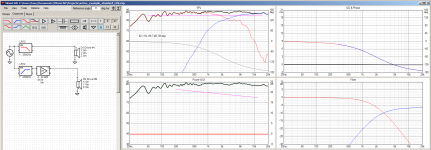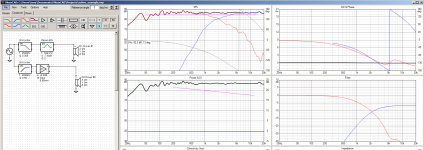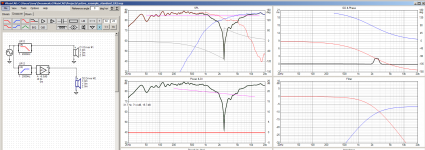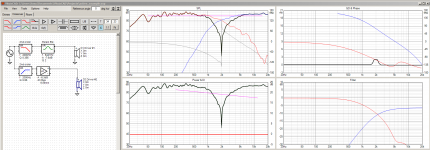Speaking broadly, a second order rolloff starting at 2k will cut anything below 1kHz more than a single capacitor filter set for 4kHz would. In other words more power in above 1k, less below. It is often an acceptable tradeoff.would LR2 on 2000 Hz be to extreme?
For what it's worth, I used to run typical domes around 1k5, sometimes lower with only a capacitor, a resistor and a resonant peak impedance filter. I'm not suggesting you do that, simply that it has been done before.
As yourself, I also would use a reasonably substantial filter. I wasn't implying earlier that I thought breakup would be a problem, especially when crossing lower. I wa thinking about beaming.If there are issues with breakup on the mids,
If you not know the individual drivers natural frequency responses which is combined with the LR2 and LR4 filters, then you can't say that you made a proper LR2 and LR4 multiway loudspeaker crossover.
So you can't say either that LR2 response is better than LR4, because you don't know what the final acoustical responses are.
So you can't say either that LR2 response is better than LR4, because you don't know what the final acoustical responses are.
If you not know the individual drivers natural frequency responses which is combined with the LR2 and LR4 filter you can't say that you made a proper LR2 and LR4 multiway loudspeaker crossover.
So you can't say either that LR2 response is better than LR4, because you don't know what the final acoustical responses are.
I think I understand that. Given my limited understanding, I tested the 'natural' frequency response of all drivers without any filters in place. The response of the tweeter is shown above (i used a sweep from I think 400 Hz to 22,000 Hz or so, not exactly sure on the digit). The result is shown in the purple line.
Is my conclusion correct? I did not test the i individual drivers with the filters intact. I did measure the freq response of all drivers with LR2 and LR4 filters on various crossovers and the frequency response curve was flattest using an LR2 filter, regardless of tweeter crossover.
I then listened using presets (fast switching between filters) in various test settings and I liked the sound of 240/2000 Hz using LR2 filters the most, although the lower crossover mattered little (240, 300 and 350 Hz).
However, one small misstep in this iterative process could have led to a wrong setup.
I'm just trying to find the optimal sounding settings without ruining my speakers. I don't mind abandoning B&W's intended filter settings, for I'm not sure if loudness was involved in their decision making. I live in a not too big appartement so that's rather a non issue for me.
Thanks for all the help so far, I really appreciated it.
Last edited:
Again, with DSP at your hands, you can correct the drivers frequency response to be flat without the crossover filters over a wide bandwidth. If you do so, you can get the same flat combined frequency response with both LR2 or LR4 or LR8 or whatever in-phase crossover you apply.
Yes, but given that an LR2 measures nicely and that I seem to like the sound, is it a bad way to go?Again, with DSP at your hands, you can correct the drivers frequency response to be flat without the crossover filters over a wide bandwidth. If you do so, you can get the same flat combined frequency response with both LR2 or LR4 or LR8 or whatever in-phase crossover you apply.
Because maybe when using LR4 I need to correct for the timing better.
I'll remeasure all the natural frequency responses when I'm home and post them.
Many variables. Maybe you have found that 2k is good, but more likely you've proved nothing more than a starting point for tweaking. It would be unlikely that you set an LR2 and get something that just works like an LR2.the frequency response curve was flattest using an LR2 filter,
You would be better giving Tony some time to sim it. A sim can give basic consideration to sound at different axes around the speaker and how this should affect the crossover.Based on your judgment, what settings seem most logical too you (using DSP)?
Because I can easily build that filter and measure it (I just have to wait a week to do that).
Yes, but given that an LR2 measures nicely and that I seem to like the sound, is it a bad way to go?
Because maybe when using LR4 I need to correct for the timing better.
I'll remeasure all the natural frequency responses when I'm home and post them.
If it measures and sounds good, then it's good. But that doesn't mean it cannot be better. That tweeter seems doesn't peaks at the low-end, so a simply LR2 filter is fine as AllenB said.
My guess is that with the LR4 filters you get too much mismatch between the individual rolloffs because of the uncorrected natural responses.
The end result would be the same for each type of filter, when considering just the natural response deviations, except for the reduced bandwidth.My guess is that with the LR4 filters you get too much mismatch between the individual rolloffs because of the uncorrected natural responses.
The end result would be the same for each type of filter, when considering just the natural response deviations, except for the reduced bandwidth.
Yeah, the reduced overlap of the LR4 version may caused worse combined frequency response. We don't know yet how the phases matches to each other, might be a strange luck with the LR2 to ended up with a better combined frequency response.
Here is a quick sim I did to show the difference between using stock LR2 filters, and custom filters. Both 2nd order at 2Khz. The standard LR2 filters when you take into account the drivers responses do not result in an acoustic LR2 roll off, and the crossover point is not 2Khz as intended.
The second pic is with custom Q's on the filters to get close to the desired 2nd order acoustic rolloff at 2000Hz. I also had to put a notch filter on the woofer to get rid of the breakup, and 20uS delay was added to the tweeter.
I just used a couple of drivers I had some frd files for.
Hope this makes things clearer.
edit: added reverse null comparisons as well.
Tony.
The second pic is with custom Q's on the filters to get close to the desired 2nd order acoustic rolloff at 2000Hz. I also had to put a notch filter on the woofer to get rid of the breakup, and 20uS delay was added to the tweeter.
I just used a couple of drivers I had some frd files for.
Hope this makes things clearer.
edit: added reverse null comparisons as well.
Tony.
Attachments
Last edited:
Thanks, it does clarify things.
I'll post individual driver responses for the filter I've build. If need be, I could adapt the Q's to see if anything improves.
I'll show the measured freq response when I have the time. I was already quite impressed.
I did have this such dip when uploading a 4th order filter at 4000hz, but at 2000th the response is really flat.
I'll post individual driver responses for the filter I've build. If need be, I could adapt the Q's to see if anything improves.
I'll show the measured freq response when I have the time. I was already quite impressed.
I did have this such dip when uploading a 4th order filter at 4000hz, but at 2000th the response is really flat.
Last edited:
- Home
- Loudspeakers
- Multi-Way
- Filter recommendation (using Hypex Software Design)



